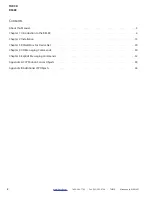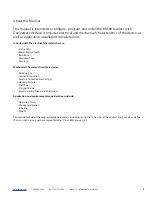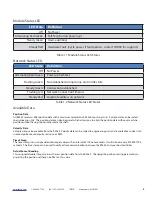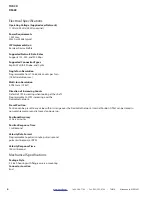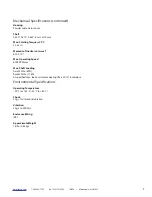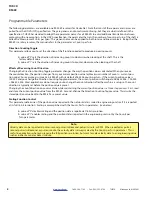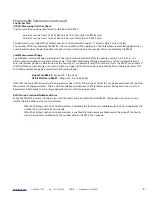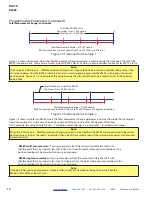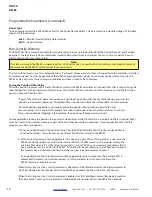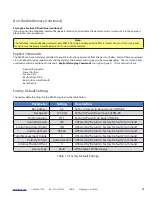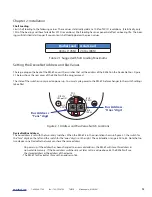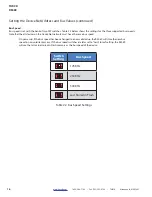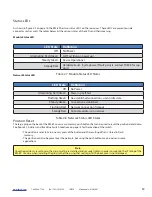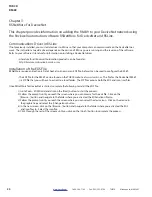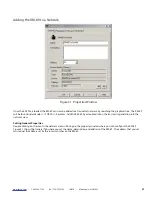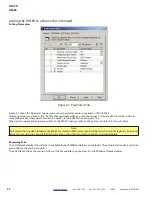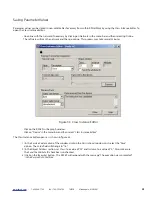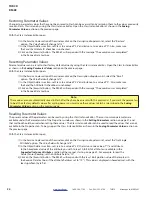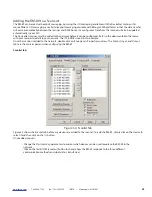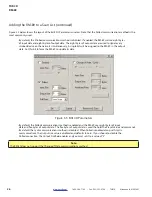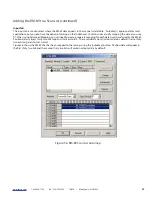
12
www.turck.com
• 1-800-544-7769 • Fax:
(763)
553-0708 • TURCK
• Minneapolis,
MN
55441
www.turck.com
• 1-800-544-7769
• Fax: (763) 553-0708
• TURCK • Minneapolis, MN 55441
13
TURCK
RM-89
Programmable Parameters (continued)
Device Type
You can program how the RM-89 defines itself to the DeviceNet controller . This parameter has a double integer (32 bit) data
type and two fixed values .
•
0x22
= Resolver Device (factory default value)
•
0x00
= Generic Device
Non-Volatile Memory
The RM-89 has Flash memory available to store parameter values and the position offset that results from a Preset Position
operation . These values are not automatically stored to flash when they are changed . You must issue a separate “Save to
Flash” command to store these values .
Note:
The Flash memory in the RM-89 is guaranteed for 10,000 write cycles . Exceeding this limit will eventually lead to failure of
the memory and the RM-89 will no longer function properly .
This limit will not be an issue for most applications . Parameter values are rarely, if ever, changed once the machine is installed
and commissioned . For those applications that often change parameter values, these values can be written down to the
RM-89 as part of the machine’s power up sequence and never stored to Flash memory .
Saving the Position Offset Value
When the position is preset with a Preset Position command, the RM-89 calculates an internal offset that is used to bring the
reported position to the programmed Preset Value . This internal offset is not stored in Flash memory and will be lost when
power is removed from the unit .
•If part of the machine’s power up sequence is homing the position, then the machine’s design as-sumes the
position is incorrect on power up . Therefore, there is no reason to store the internal offset to Flash memory .
•Absolute position applications will usually preset the position during machine installation and
commissioning . The “Save to Flash” command is then issued once to store the internal offset . As long as
there is no mechanical slippage in the machine, the position will always remain correct .
Some applications require the position to be preset multiple times while the machine is running and the last internal offset
must be stored to non-volatile memory as part of the machine’s power down sequence . If your application falls into this
category, you have two options:
1) When you need to preset the position value from the RM-89, calculate and store the required offset in
your host controller . You will never issue a “Preset Position” command to the RM-89 .
2) Set the
Total Measurement Range
parameter to a non-zero value . When this parameter is non-zero, the
RM-89 constantly updates and stores the internal offset in a FRAM memory . This includes storing the
internal offset when a “Preset Position:” command is issued . FRAM is a new memory technology that is
non-volatile, but can be written to like RAM . (According to the manufacturer’s specifications, writing to
the memory every millisecond will burn out the memory in approximately 300 years .)
If you decide to use the
Total Measurement Range
parameter only to make sure the internal offset is
automatically stored in non-volatile memory, set this parameter to its maximum value so the
RM-89 remains an absolute sensor .
•When
the
Scaling Function Control
parameter is disabled, set the Total Measurement Range parameter to
65,536 multiplied by the number of turns the RM-89 can encode . (65,536 or 268, 435, 456 counts)
•When
the
Scaling Function Control
parameter is enabled, set the Total Measurement Range parameter to
the value of the
Counts per Turn
parameter multiplied by the number of turns the RM-89 can encode .
Summary of Contents for DeviceNet RM-89
Page 1: ...USER MANUAL MA1007 REV B Published 4 15 2015 RM 89 DeviceNet Resolver...
Page 14: ...14 www turck com 1 800 544 7769 Fax 763 553 0708 TURCK Minneapolis MN 55441 TURCK RM 89 Notes...
Page 38: ...38 www turck com 1 800 544 7769 Fax 763 553 0708 TURCK Minneapolis MN 55441 TURCK RM 89 Notes...


